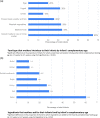Mothers' feeding practices among infants (4-12 months) and associated factors: a cross-sectional study in Saudi Arabia
- PMID: 36304820
- PMCID: PMC9554420
- DOI: 10.1017/jns.2022.85
Mothers' feeding practices among infants (4-12 months) and associated factors: a cross-sectional study in Saudi Arabia
Abstract
A global target of increasing exclusive breast-feeding (EBF) to at least 50 % by the year 2025 was set by the WHO for infants under 6 months. The lowest prevalence in the world was found in the Eastern Mediterranean region in 2010-18 and little is known about the status of mothers' feeding practices in Saudi Arabia. The present study aimed to assess mothers' actual feeding and weaning practices used with their infants by the mothers' different age groups. The present study was conducted among 247 mothers of infants aged 4-12 months who were attending public well-baby clinics. Quantitative data were obtained by nutritionists using an electronic semi-structured questionnaire about mothers' feeding practices. Only 5·3 % of mothers engaged in EBF, 44·9 % breast-fed their infants after an hour of birth, while 92·7 % of infants had ever been breast-fed. The average intent/plan to continue breast-feeding was 4·9(±3·1) months. Younger mothers introduced weaning food around 4 weeks earlier than older mothers (mean differences were -0·4, 95 % CI -0·71, -0·13; P = 0·031). A total of 64·3 % of infants received complementary feeding before completing 17 weeks. Maternal age group and delivery mode were the only factors associated with the early introduction of complementary feeding. A total of 69·2 % of the mothers believed that 'it is a good time' and 61·1 % felt that 'infants are hungry and need other sources of food'. Online sources and family advice were the top sources of information on mothers' feeding practices. Provision of professional advice about EBF and optimal weaning practices are significant areas for improvement in terms of compliance with recommended infant feeding practices.
Keywords: Breast-feeding; Infants health care; Mothers’ feeding practices; Saudi infants; Weaning practice.
© The Author(s) 2022.
Figures
References
-
- World Health Organization (WHO) (2020) Infant and young child feeding. Available at https://www.who.int/en/news-room/fact-sheets/detail/infant-and-young-chi....
-
- Fund WHOUNCs (2003) Global strategy for infant and young child feeding Geneva. Available at http://www.who.int/nutrition/publications/gs_infant_feeding_text_eng.pdf - PubMed
-
- World Health Organization (WHO) (2022) Health topic: breastfeeding, recommendations. Available at https://www.who.int/health-topics/breastfeeding#tab=tab_1.
-
- Nasreddine L, Zeidan M, Naja F, et al. (2012) Complementary feeding in the MENA region: practices and challenges. Nutr Metab Cardiovasc Dis 22, 793–798. - PubMed



